A Complete Guide to Gen AI Development Services
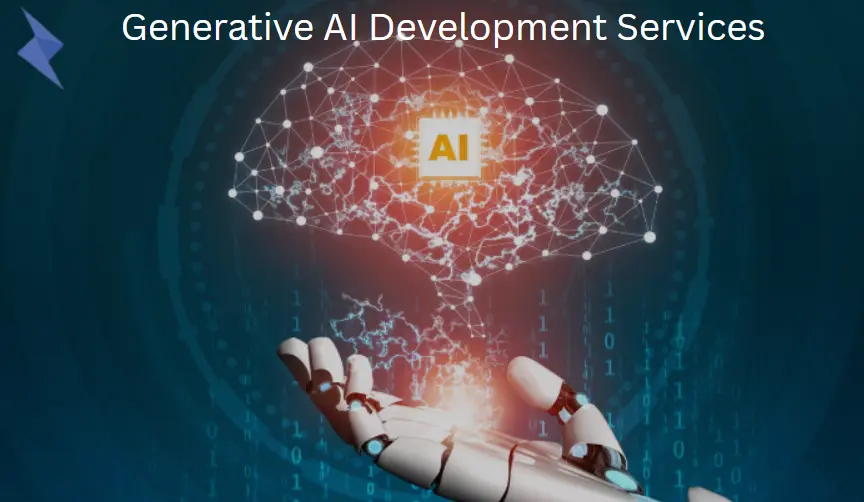
Generative AI is changing how businesses create, innovate, and deliver solutions. Gen AI development services help organizations automate creativity with the ability to create realistic images and produce human-like text, products, or information. This blog focuses on what generative AI is and how it works, what generative AI software development companies can do for businesses, and the best way to choose the right service.
In the latest report, the demand for Generative AI products is expected to rise up to $80billion, driven by virtual assistants, infrastructure products, and copilots that speed coding.
In the latest report, the demand for Generative AI products is expected to rise up to $80billion, driven by virtual assistants, infrastructure products, and copilots that speed coding.
What Are Generative AI Development Services
Gen AI development services encompass the design, construction, and deployment of artificial intelligence systems capable of generating new content, ideas, or data, like humans. These services differ from traditional AI in the fact that they enable a machine to produce original outputs, including text, images, audio, video, computer code, and even product designs.
How Generative AI Works
Generative AI applies the use of models, including (but not limited to) Generative Adversarial Networks (GANs), Variational Autoencoders (VAEs), and Large Language Models (LLMs) (such as GPT-4, Gemini, Claude) to learn massive datasets, and generate similar outputs that are unique. Gen AI development services leverage these models to create innovative solutions tailored to business and creative needs.
These models learn via state-of-the-art machine learning techniques involving data, various patterns, structures, relationships, etc. After the model is trained properly, these Gen AI models can produce content that is entirely different and new, is very contextual, and many times indistinguishable from human work.
These models learn via state-of-the-art machine learning techniques involving data, various patterns, structures, relationships, etc. After the model is trained properly, these Gen AI models can produce content that is entirely different and new, is very contextual, and many times indistinguishable from human work.
Importance of Generative AI Development Services
1. Model Selection and Training
Then, depending on the creative task and the project objective to create images, text, music, or code, researchers will either select data from or establish models (GPT, Stable Diffusion, DALL·E).2. Data Engineering and curation
High-quality data is the basic step of a generative AI system. Development teams will pre-process, clean, and structure data to suit the planned use case.3. Integration into Applications
Generative AI models may be deployed via APIs or integrated directly into software products. Services include UI/UX design, real-time generation, and cloud-based integrations.4. Customization and Fine-tuning
Companies want models that demonstrate their brand voice, domain knowledge, or regulatory limitations. Developers will modify the model for accuracy, safety, and creativity.5. Monitoring, Testing & Optimization
Once deployed, development teams will monitor outputs, control for risks such as bias or hallucinatory outputs, and utilize A/B testing, client feedback, and other methods to optimize performance.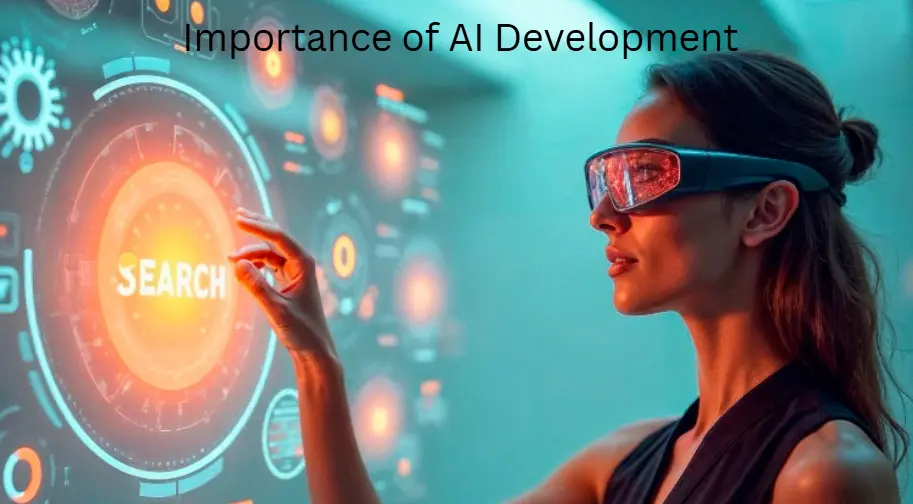
Ready to explore how Generative AI can impact your products?
Our team helps integrate cutting-edge models like GPT, DALL·E, and Stable Diffusion into real-world business applications.
The Development Lifecycle of Generative AI Systems
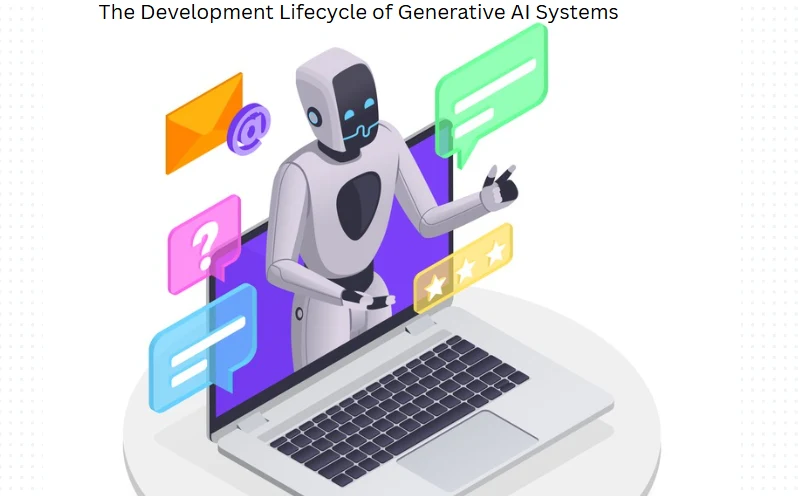
Building a productive & trustworthy generative AI system takes more than a trained model; an AI developer company undertakes a structured, multi-phase software development lifecycle approach to ensure the system performs effectively, ethically, and securely. Each phase of this generative AI development company in India's lifecycle is integral in taking raw information and transforming it into intelligent, creative output.
Defining Objectives & The Use Case
The development process commences when teams define what outcomes the generative AI system will create. In defining these objectives, teams need to specify the objectives of the generative AI system; whether generative AI will model text, create art, compose music, or synthesize information, developers ensure that AI capabilities are aligned to particular outcomes in the context of either business or creativity.
Key Tasks:
Key Tasks:
- Identify target users and corresponding use cases
- Define performance metrics and success criteria
- Confirm alignment with ethical and regulatory guidance
Data Collection & Preparation
Data serves as the fuel for all generative AI models. When developers first acquire data, they curate high-quality examples of various styles or domains of the output they desire. Once a dataset is obtained, developers will clean, annotate, and curate the data to provide consistency and relevance.
Key Activities:
Key Activities:
- Scrape data or obtain datasets from reputable repositories
- Remove noise, bias, or inconsistencies
- Normalize formats for feeding into training algorithms
Model Architecture Selection
Enterprise Software Developers will choose the most appropriate model, based on the use case choosing from the Transformer, GAN, VAE, or Diffusion model. Developers can also use pre-trained models or build their own from scratch, if necessary, and the application requires a lot of customization.
Key Activities:
Key Activities:
- Decide the right kind of architecture based on the type of content (Text, Image, Audio, etc.)
- Open source models or API (eg, GPT, DALL·E, Stable Diffusion)
- Make certain the model/backend will scale and train efficiently.
Train and Fine-Tune the Model
Developers train a model using either labeled or structured datasets. During this phase, they fine-tune model parameters to obtain higher output quality and to collaborate in reducing bias. They typically perform multiple iterations and make adjustments to hyperparameters until they are convinced the model is performing in the way intended.
Key Tasks:
Key Tasks:
- Monitor training loss and performance indicators
- Fine-tune the model using domain-specific
- Check the model for validity, consistency, and significance.
Testing for Quality
Developers ensure the model doesn’t generate harmful, distorted, or biased content, and they test the model across a wide variety of inputs and test settings.
Key Tasks:
Key Tasks:
- Conduct bias and safety audits
- Use automated and high-level testing
- Establish ethical guardrails.
Model Deployment
After testing and validation, the model will be put to production by the developers. This will commonly include deploying the model on cloud infrastructure, cre,ating APIs or including it in applications/user interfaces to meet user/business requirements.
Some of the tasks here include:
Some of the tasks here include:
- Build user front-end or back-end developer APIs
- Focus on latency, scalability, and uptime
- Build in monitoring systems and maintenance procedures for ongoing functionality
Model Monitoring, Updates, and Maintenance
Once the model is deployed, teams need to continuously monitor the model in a real-world scenario. Developers will keep an eye on performance numbers and gather user feedback as they also strive to ramp the model up for updates as necessary. It’s necessary to update them, otherwise they will inevitably end up being factually wrong, outdated, and potentially even unethical down the line.
Some of the tasks here include:
Building and maintaining generative AI and the development lifecycle need to be planned, ethical, and better. “If executed well, the devs will have an AI system that can generate amazing content and also deliver on a real, human level in business value and trust with users. Each phase of the development lifecycle will serve as a solid foundation for building responsible, intelligent, and creative AI.
Some of the tasks here include:
- Retraining models with new data will ensure your system's accuracy.
- Monitoring the model output to indicate unexpected outputs, or more troubling, misuse.
- Patch (fix) security holes and shore up the safety nets in your system.
Building and maintaining generative AI and the development lifecycle need to be planned, ethical, and better. “If executed well, the devs will have an AI system that can generate amazing content and also deliver on a real, human level in business value and trust with users. Each phase of the development lifecycle will serve as a solid foundation for building responsible, intelligent, and creative AI.
Why Companies Are Using Gen AI Services
Companies are looking into gen AI development services because they can reduce costs related to content creation and design cycle time, improve the speed of productivity, and foster innovation. Generative AI services enable organizations to improve upon the creative process, produce personalized or customized content at scale, and develop automation where it was previously not possible.
Gen AI development services represent a transformative jump in how organizations use technology. They offer the ability for machines to create, not just calculate, instead of a Petabyte of content and other things. They allow organizations to rethink what's possible in content and design. Generative AI supports smarter applications, dynamic user experience, and scalable creative workflows that will drive next-generation innovation.
Gen AI development services represent a transformative jump in how organizations use technology. They offer the ability for machines to create, not just calculate, instead of a Petabyte of content and other things. They allow organizations to rethink what's possible in content and design. Generative AI supports smarter applications, dynamic user experience, and scalable creative workflows that will drive next-generation innovation.
When Should a Business Consider Building a Custom AI Solution
Not sure if a custom AI solution is right for you? Let’s talk.
The Benefits of Gen AI Development Services
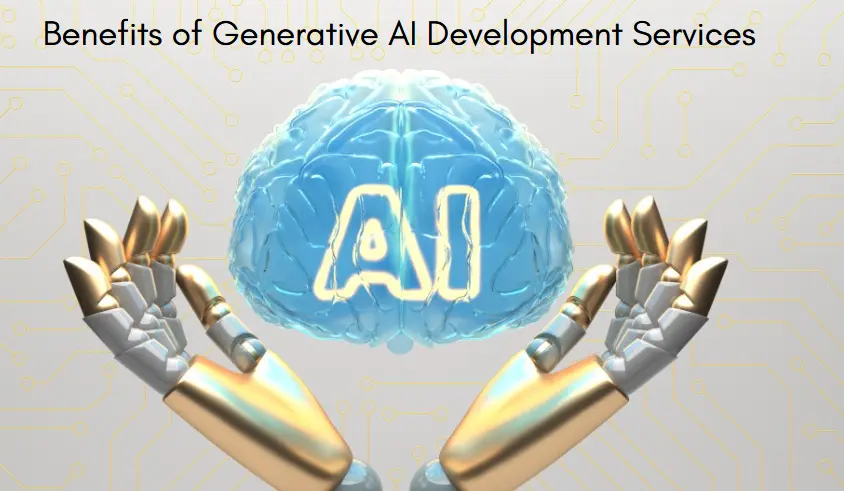
Gen AI has specific benefits in different industries. Here are 5 examples:
Fast Content Creation
On the other side of things, AI can write articles, product descriptions, scripts, and marketing copy in minutes, enabling companies to turbocharge their content creation and scale their business without hiring more people.
User-specific Experience
AI systems can generate content specific to users, producing recommendations, emails, or interfaces that change with learnings based on customer behavior.
Improved Productivity
Generative AI tools can handle work for developers, marketers, and designers. Work such as coding, writing, and graphic design.
Cost Savings
Able to automate operational processes, organizations can lower operational costs and spend their resources on research and development.
Fast Prototyping and Innovation
Companies can generate prototypes, ideas, and mockups powered by generative models and move to market much more quickly.
The Use Cases of Gen AI Development Services
Gen AI development services are changing the way businesses operate, create, and interact with their users. By allowing machines to create new content and solutions, businesses of all shapes and sizes are exploiting new efficiencies, as well as entirely new avenues for creativity.
Here are some use cases:
Here are some use cases:
Content Generation and Marketing Automation
Marketers and content creators alike are now using generative AI to create blogs, articles, product descriptions, email campaigns, and ad copy at scale.
How it helps:
Offers the ability to personalize messaging for distinct audiences
Examples:
How it helps:
- Accelerates content creation
- Creates a consistent brand voice across platforms
- Automates repetitive writing processes
Offers the ability to personalize messaging for distinct audiences
Examples:
- AI-produced SEO blogs
- Suggested social media posts
- Email subject lines and ad copy
Image and Graphic Generation
Design teams are using DALL·E, Midjourney, and Stable Diffusion among the many tools available in the market to generate logos, illustrations, concept art, and marketing assets. AI can quickly create a high-quality visual asset from a written prompt.
How it helps:
Examples:
How it helps:
- Enables rapid prototyping
- Reduces reliance on stock photos
- Generates images for a specific style or theme
Examples:
- UI mock-ups
- Concept art for a game character
- Product photos for e-commerce
AI-Enhanced Software Developments
Generative AI models such as GitHub Copilot and Amazon CodeWhisperer use natural language to assist software developers with writing, optimizing, and debugging their code.
How it helps:
Examples:
How it helps:
- Enhance developer productivity
- Reduce the likelihood of coding errors
Examples:
- Autocomplete snippets of code
- Generate unit tests
- Translating pseudocode into functioning code
Conversational AI and Chatbots
Companies use Gen AI Development Company in India to provide customer service and support, like answering customer questions, scheduling appointments, and troubleshooting with human-like conversational responses.
How it will help:
Examples:
How it will help:
- Improves user engagement
- Always available
- Reduces the workload of support teams
Examples:
- AI chatbot for websites and mobile apps
- Voice assistants using natural conversation
- Virtual agents for banking or e-commerce
Gaming and Entertainment Content
Video game studios and media companies engage gen AI development services to build storylines, levels, music, characters, and even real-time dialogue in games.
How it will help:
Examples:
How it will help:
- Increases speed of game design, world building
- Provides a personalized experience for users
- Fosters procedural generation in open-world gaming
Examples:
- AI-generated background music
- NPC dialogue tree with emotional intelligence
- Auto-generating levels by AI
Synthetic Data Generation
In industries where the information has the potential to be valuable to a company, such as in health care and finance, "generative AI can create realistic synthetic data sets to allow a company to train models independent of a company's data, or test these applications, without ever having to expose sensitive customer information."
How it will help:
Examples:
How it will help:
- Protects sensitive data
- Optimizes model accuracy
- Supports robust testing environments
Examples:
- Simulated records on patients
- Data sets of financial transactions
- Simulated e-commerce user behavior
Video and Audio Generation
AI is now able to follow vocal prompts to produce voice-overs, soundtracks, and video from either text prompts or points of reference.
How It Helps:
Examples:
How It Helps:
- Reduces production time and costs
- Supports multi-lingual content production
- Helps creators who may not have the technical language
Examples:
- Voice cloning for narrations
- AI-generated training or explainer videos
Document Summarization and Text Analysis
Generative AI can read long documents, contracts, or reports and can highlight certain key points from them and summarise them in a tabulated format for further use by analysts, the legal team, or senior management. Generated AI, for one, is about saving time for analysts, legal staff, and senior execs—to use the AI to abstract points and distill lengthier text/texts to an immediately digestible format.
How It Helps:
Example:
How It Helps:
- Provides immediate insights into key points
- Results in better decision making
- Removes manual data review work
Example:
- Legal contract summaries
- Summaries of market research reports
- Summaries of news items and trends
Product & UX Personalization
E-commerce and SaaS companies can use generative AI to build individualized product and template recommendations, onboarding flows, and UI components based on user landscape behavior.
How It Helps:
Examples:
How It Helps:
- Improved user engagement and conversion rate
- Customized user journey
Examples:
- AI-populated product bundles
- User-specific dashboard layout
- Tool tips and help text that are contextually based on user behavior and choices.
Have a use case in mind for Generative AI?
We help startups and enterprises bring ideas to life with scalable AI-driven solutions.
Important Technologies and Algorithms in Gen AI
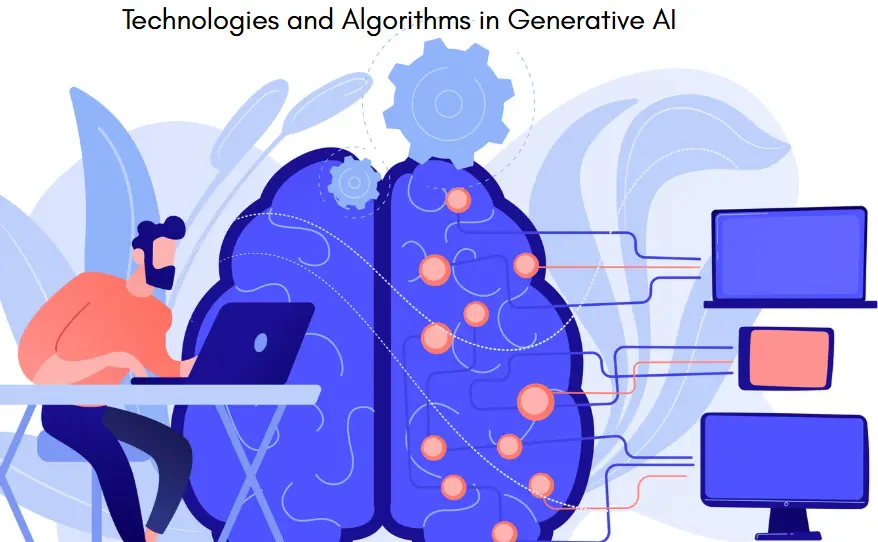
Generative AI encompasses a variety of cutting-edge tech and algorithms that enable machines to create content such as pictures, text, music, or code. The developer assembles smarter platforms by creating basic toolkits that allow machines to find patterns, imitate styles, and turn out human-like material. The following are the most critical technologies and algorithms used to develop generative AI today.
Generative Adversarial Networks (GANs)
GANs have been the research method used to develop machines to generate very realistic outputs. GANs usually have two neural networks, which have defined roles as either the generator or the discriminator. Intuitively, the generator produces data that gets more and more realistic while the discriminator gets better and better at analyzing data to determine whether or not it is real or fake until the generator can no longer produce data that the discriminator can decipher as real and not fake.
Use Cases:
Use Cases:
- Generation of images and video
- Deepfaking
- Game assets and playscape concepts.
Variational Autoencoders (VAEs)
VAEs are neural networks that learn to encode a compressed version of the input data in a latent space and then reconstruct the compressed data. The difference between traditional autoencoders and VAEs is that VAEs include a probabilistic layer that allows the models to create new variations, and not just reconstruct the inputs that were presented.
Use cases:
Use cases:
- Image synthesis and enhancement
- Music and sound generation
- Feature interpolation (e.g., face morphing)
Transformers and Attention Mechanismss
Transformers are the basis for the most advanced generative AI models that are being used today, such as GPT, BERT, and T5. The transformer architecture and self-attention mechanism enable these models to recognize relationships among words, sentences, and data points, making them a perfect choice for natural language generation and understanding.
Use Cases:
Use Cases:
- Text generation and summarization
- The usage of virtual assistants and chatbots
- Code and script generation
Diffusion Models
Diffusion models do the reverse process to change the noise into data. Recently, they have become popular for generating high-fidelity images and complex styles of art.
Use Cases:
Use Cases:
- AI art and digital illustrations
- Photorealistic image generation
- Game texture design and environment design
Reinforcement Learning (RL)
For generative AI, developers hold Deep Reinforcement Learning to improve content through user feedback or learned goals. The AI tests different routes and is rewarded for generating desirable or accurate content.
Use Cases:
Use Cases:
- Optimizing personalized content
- Adaptive game level and character behavior
- Conversational AI learning from users
Auto-Regressive Models.
Auto-regressive models generate outputs by analyzing the next value with the benefit of values in the sequence. A strong example of this is GPT (generative pre-trained transformer), which generates sentences one word at a time, along with the historical context it has available.
Use Cases:
Use Cases:
- Story or dialogue generation
- AI songwriting
- Predictive text and language models
Neural Style Transfer
Neural style transfer is the ability of a neural network to copy of one image and apply it to the content of another. This is another technique that developers use with visual reasoning and ultimately wherever aesthetics are notable (with visual content).
Use Cases:
Generative AI powerhouses like these are on the bleeding edge of what developers can currently build with generative AI. Both have unique strengths that make one or the other better suited for certain types of media, business, or creative requirements. Ultimately, when combining these technologies intelligently, it allows businesses to create intelligent generative systems that learn, adapt, and continually start to innovate.
Use Cases:
- Artwork generated by AI
- Game and app theming
- Creating custom filters for photo editing tools
Generative AI powerhouses like these are on the bleeding edge of what developers can currently build with generative AI. Both have unique strengths that make one or the other better suited for certain types of media, business, or creative requirements. Ultimately, when combining these technologies intelligently, it allows businesses to create intelligent generative systems that learn, adapt, and continually start to innovate.
The Right Gen AI Development Partner
When thinking of choosing a generative AI development service provider, you should think about a couple of things:
- Knowledge of AI Models: Make sure they have experience using GPT, LLaMA, Claude, and other leading models.
- Capability to Customize: Look for the provider that is capable of fine-tuning models to your business.
- Data Security and Compliance: The company that obeys ethical AI practices while managing your sensitive data is crucially important.
- Scalability and Integration: You must also verify that the AI solution is scalable and can be hooked into whatever tech you have in place now.
- Support: Make sure you choose a partner with continuing development support: this means updates, optimization, performance, and support.
Trends that are Impacting the Future of Gen AI Development Services
Use these trends to keep your organization ahead of the curve:
- Multimodal Models: New combining text, image, and audio generation
- Real-Time Application AI: Creating content on the fly for rendering games, customer service, and XR (mixed reality).
- Ethical AI: Emphasis on fairness, transparency, and minimization of bias in every piece of content produced.
- Low-Code AI Tools: Allow for less technical users to use generative AI models simply
Future-proof your business with generative AI.
Whether it’s smarter content, dynamic UX, or custom automation, Rytsense can help you lead with intelligence.
Gen AI Development Services: Transforming Innovation
Gen AI development services focus on designing, training, and deploying advanced AI models that generate original content, including text, images, videos, and code. By using technologies like GANs, VAEs, and Large Language Models, these services enable businesses to automate creative processes, personalize user experiences, and streamline workflows. From building AI chatbots to generating marketing assets or synthetic data, gen AI development services help organizations unlock new growth opportunities through intelligent automation and innovation.
Conclusion
Gen AI development opens doors for businesses that are looking to innovate and act creatively with automation. Working with the partner development team can take you and your organization to the next level of generative AI automation and unique user/customer experiences.
Whether you're a startup or an enterprise, investing in a generative AI development Company in the USA as a foundation for scaling your brand can set you apart from the competition when it comes to digital transformation.
Whether you're a startup or an enterprise, investing in a generative AI development Company in the USA as a foundation for scaling your brand can set you apart from the competition when it comes to digital transformation.

The Author
Karthikeyan
Co Founder, Rytsense Technologies